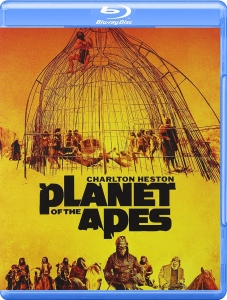This series celebrates 50 years of the “Planet of the Apes” franchise. We naturally start with the original film, which hit theaters on April 3, 1968.
The original “Planet of the Apes” movie is groundbreaking and dated, flawed and fascinating. It still holds up today by every important measure, but – while the ape makeup effects, Jerry Goldsmith’s chillingly primitive score and the desert vistas and ape community sets are worthy talking points – it’s the narrative that makes the film timeless.
While sometimes labeled a “twist” ending, the final scene where Taylor (Charlton Heston) realizes he is on Earth isn’t a repositioning of what we’ve learned so far, it’s a confirmation.
Indeed, Taylor and the audience should know this planet is Earth (or at least linked to Earth) by the fact that the apes speak English. It’s because of an established filmic convention that the character and moviegoers don’t immediately draw that conclusion. “Star Trek” wrapped its second season the week “Apes” premiered, so sci-fi connoisseurs were accustomed to human explorers finding English speakers (and near-humans) on alien planets, with no explanation given or asked for.
Beyond that, “Planet of the Apes” is essentially an epic “Twilight Zone” episode: Rod Serling and Michael Wilson rework Pierre Boulle’s novel into a parable where the apes stand in for man after man has ceded the throne. It’s not a direct parallel to 1968 humanity; this ape culture is civilized but also has pre-Enlightenment aspects. Science and religion are one and the same – and are state-controlled — leading to a frustrating loop where it’s hard to spread truth if that truth contradicts the Scrolls, something early astronomers such as Galileo had to contend with.
The early portion of the film aims for a blockbuster (although that term wouldn’t be invented till 1976’s “Jaws”) hook with a space-travel light show and Heston’s stentorian monologue about how time bends and he feels lonely. As the three stranded astronauts from 1973 America traverse the desert – which the apes call the Forbidden Zone and which was filmed in Utah, Arizona and California – a modern viewer expects to see Jawas pop out of a crevice or to be treated to a plateau-top view of Mos Eisley Spaceport.
That doesn’t happen, but the wide vistas are nonetheless impressive as director Franklin J. Schaffner delivers in-camera grandeur such as our heroes traversing the bottom of a gorge while the apes track them along the ledge above. As the film goes on, we see Schaffner is enamored with his camera’s zoom function, and because that style didn’t catch on through the years, it locks the movie in 1968 — but that’s OK.
Once Taylor is captured, the film becomes a cerebral masterwork, with the ape makeup being plenty good enough for a viewer to go with it, even today. First, we’re treated to the notion of humans’ and animals’ places in the world being flipped – it’s a “madhouse” to Taylor, but it’s very easy for a viewer to see what’s going on. Then the religion-versus-science conflict comes to the fore in the trial of wife-and-husband scientists — and Taylor’s more-or-less friends — Zira (Kim Hunter) and Cornelius (Roddy McDowall).

(“Planet of the Apes” doesn’t exactly pass the Bechtel Test, but it should be noted that Zira is the film’s hero. Main character Taylor requires a coup led by Zira to be sprung from his cage. While he does arm himself and make it clear he’s done taking s*** from the apes, he doesn’t exactly have a plan of action. That still comes from Zira, who suggests that a trip to Cornelius’ archeological dig might turn the tables on political/faith leader Dr. Zaius. This strong female SF character tends to be lost to history. Film historians are understandably distracted by the fact that the lone woman astronaut, Lieutenant Stewart, dies in cryo-sleep, and that Linda Harrison’s voiceless Nova is arm candy for Taylor.)
Snuck into the mix is the implication that Zaius (Maurice Evans) is well aware that intelligent humans predate intelligent apes. In the end, we see why – at least from the viewpoint of a staunch collectivist like Zaius – free-thinking and speaking humans are worth fearing: They recklessly destroyed their own civilization.
But does “Apes” specifically tell us that humans destroyed themselves, or do we just infer it because Taylor jumps to that conclusion (“You maniacs! You blew it up!”), and because increasingly destructive war weapons were a common concern of sci-fi writers in 1968? Recall that mere scenes earlier, Taylor suggests that disease or something from outer space knocked humanity back a peg. No evidence is presented to invalidate those hypotheses.
This might be a case where, through the years, we’ve collectively confounded the original film with the franchise as a whole, which went on to delve into wars and nuclear weapons. Or maybe Taylor – and we the audience, as his mute companions – simply look at the trajectory of humanity and extrapolate that “Yeah, we probably did blow ourselves to hell.”
Still, Taylor is a strange one to take our cues from. At the beginning, he lectures Landon (Robert Gunner) about how there has to be something better in the galaxy than humanity. It’s both a pessimistic (he has given up on humanity) and optimistic attitude (he hasn’t given up on life in general).
But I’m not sure I trust Taylor: When he sees the primitive humans, he’s encouraged by the prospect of becoming their ruler. What’s more, he is leading up a hugely expensive government-funded mission to fly off randomly into space. The film’s NASA equivalent is well aware that – due to time dilation – current Americans can’t benefit from it, even in terms of gaining knowledge. Nor will humanity as a whole benefit: Since the mission includes just one woman, a new society can’t be started (unless it is horrifically inbred). So even if we imagine that knowledge about their landing site can be transmitted back to humans of the future, it’s only going to be one generation’s worth of knowledge.
Admittedly, the “you are your fate” arcs of the other astronauts nudge us to see Taylor as a soothsayer. We’re told that Stewart is tasked with bearing children in order to start a human outpost; that’s impossible, and it becomes more bluntly impossible once she’s dead. Landon, who is fine with being immortalized as a statue, is lobotomized, so he might as well be a statue himself. Dodge (Jeff Burton), a voracious scientist, is stuffed and displayed in a museum for scientifically curious apes to learn from.
Taylor assumes his worst fears are true (that humanity’s self-imposed collapse has been completed), so we accept his assumptions are correct, since all of the film’s cues (except for actual evidence) aggressively point us in that direction. A street-corner doomsayer in an astronaut’s suit, Taylor gets his dramatic confirmation on this otherwise random mission.
(A less biased thinker would make a connection between the absence of the moon and humanity’s collapse. While it’s possible that humans could blow up the moon, a celestial event would still be more plausible.)
Indeed, “Apes” suggests that not only did humans destroy themselves, but apes are following the same path. The latter point is not emphasized by any overacted Heston scenes, but it’s shown by the all-too-human social structures: religion, sham trials, classism within a society that claims to reject it, and – of course – arrogance about their species’ place in the hierarchy of life. And there’s also Taylor encouraging budding hippy chimp Lucius (Lou Wagner) to not trust anyone over 30.
“Planet of the Apes” is a great story, but doesn’t feel like the full story. Big, mainstream sci-fi franchises weren’t a thing before “Apes,” but – looking at the story itself – it’s quite natural that this would become the first. (Or the second, depending on your point of view. The “Star Trek” TV series started in 1966, but it didn’t become a mega-franchise until after “Apes” proved such a thing was possible. The first “Trek” movie hit theaters in 1979.)
Everything about “Apes” a little too epic for the viewers – and the storytellers – to leave it as a one-off “Twilight Zone”-ish fable.

